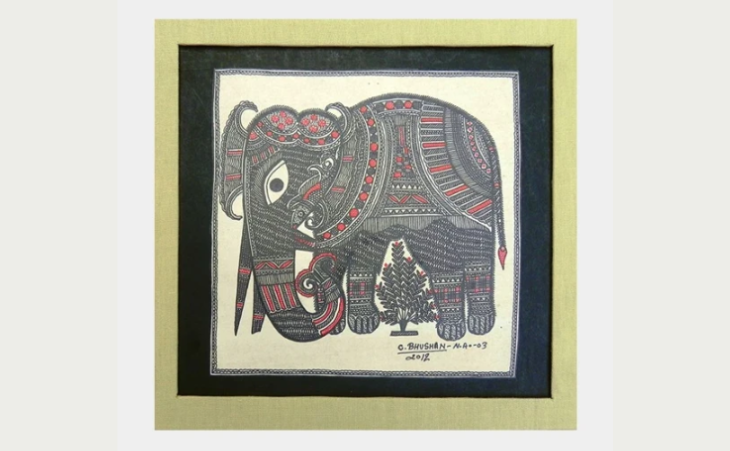Madhubani Painting: History, Styles, Materials & How to Identify Originals
What is Madhubani Painting?
Madhubani painting is celebrated for its rich colours, intricate designs, and narratives rooted in culture and mythology. Also known as Mithila painting, the art form originates from the Mithila region of Bihar and has spanned centuries, evolving from primitive mud wall paintings to valued pieces of canvas in art galleries abroad.
You are an art patron, culture traveller, or an art buyer beginner; in this article, we will take you through the history, beauty, and meaning of Madhubani painting, and give you advice on how to recognise authentic Madhubani paintings and where to buy them.
History of Madhubani Painting
Madhubani art originated centuries ago and is rich in folklore and tradition. According to legend, King Janaka of Mithila hired artists to paint the walls of his daughter Sita's (of Ramayana fame) wedding venue with stunning works of art, thus establishing the practice.
It is not ornamentation—it is prayer, narration, and heritage. Women begin painting at weddings, festivals, or the birth of a child now, and each brush stroke is filled with emotion and heritage.
They were first used by the women of the region, who created such murals on freshly plastered floors and walls using natural pigments made from plant life, flowers, and minerals. Religious rituals, social rituals, festivities, and landscapes were some of the subjects.
In the 1960s, a ruinous drought forced the Indian government and cultural researchers to convince village women to record their paintings on paper as a means of livelihood. This was the breakthrough, ushering Mithila painting onto the mainstream scene, turning an in-house tradition into a celebrated art form worldwide.
Mithila Painting: A Living Tradition
At the root of Mithila art is its very existence as a living, tangible form of culture, most remarkably in the hands of rural women of Bihar. Women born into Dalit families and other repressed communities of society have carried forward the tradition with greater passion and imagination, passing the unique technique and style through generations, infusing individual belief, communal rituals, and everyday life into painting.

Madhubani artist doing folk art using natural dyes, image source: Google
Notable artists such as Sita Devi, Ganga Devi, and Baua Devi have been instrumental in bringing Madhubani painting to the forefront, both nationally and internationally. All three have been honoured with the prestigious Padma Shri award for their remarkable contributions to this traditional art form, a testament to their talent and the cultural significance of their work.
What Is So Gorgeous About Madhubani Painting?
Madhubani painting's beauty lies in its finer detail, symbolic motifs, and colour richness. Every paper or canvas square inch is utilised to present designs—flower borders, geometric patterns, and soft lines that add depth to the narrative.
 Madhubani painting by Chandra Bhushan Kumar, image Source: Gallery Unique Art
Madhubani painting by Chandra Bhushan Kumar, image Source: Gallery Unique Art
Some startling features are:
- Paintings are two-dimensional, flat, with no perspective.
- Often use bold lines with sticks, matchsticks, or nib pens.
- Use of natural dyes includes turmeric, indigo, sandalwood, and neem.
- There are no blank spaces—the whole background is covered with patterns of ornamentation.
- Most of the themes come from Hindu deities (such as Krishna, Shiva, and Durga) to animals, trees, weddings, the sun, and the moon.
What are the Styles of Madhubani paintings?
There are five distinct styles of Madhubani painting:
- Bharni: Bold Colours and filled outlines.
- Kachni: Delicate line work with minimum colours
- Tantrik: religious and mystical motifs
- Godna: Tattoo pattern-based
- Kohbar: Associated with wedding and fertility rites
All styles have a unique appearance while bearing the essence of Mithila.
Original Madhubani Paintings vs. Replicas
With rising popularity, Madhubani painting are finding their canvas on everything—from bedsheets and bags to wall art and stationery. But if you’re looking to purchase an original Madhubani painting, it's essential to know the difference between authentic pieces and mass-produced designs.
How to Identify an Original Madhubani Painting
Materials Used in Madhubani Paintings:
- Traditional artists use handmade paper, natural fabric, or canvas.
- Colours are derived from natural sources like indigo, turmeric, and plant extracts.
Techniques & Detailing:
- Original Madhubani art is detailed with fine linework and motifs.
- Every space is utilised; the background is richly filled.
- Modern versions might employ acrylics but still retain stylistic integrity.
Artist Signatures:
- Many serious artists sign pieces in local script.
- Some art is sold with certificates of authenticity or sold through established artisan collectives.
Themes & Style Consistency:
- Traditional work follows the traditional themes—mythology, rituals, and nature.
- Look for local designs like Bharni or Kachni for authenticity.
- Buying from the right sources ensures that not only are you getting an authentic art piece, but you are also helping in the sustenance of traditional artists.
Where to Buy Authentic Madhubani Art
For those looking to own an authentic piece of Madhubani art, the Gallery Unique Art in Delhi is a trusted destination.
 Buy original Madhubani paintings from a certified artisan gallery, image source: Gallery Unique Art
Buy original Madhubani paintings from a certified artisan gallery, image source: Gallery Unique Art
Known for its curated collection of original, hand-painted works by traditional artisans, the gallery offers both offline and online shopping options.
Whether you're a collector or a first-time buyer, Unique Art Gallery ensures quality, authenticity, and a chance to support the real artists behind this timeless Indian folk art.
Direct from Artists:
You can also contact art cooperatives like Mithila Art Institute or Darbhanga Artisans Collective for commissioned paintings. This ensures authenticity and is suitable for artisans' fair wages.
Madhubani painting is not just a folk art tradition—India's cultural heritage, fostered over the ages by generations of women folk artists in rural Bihar. Its transition from mud walls to museum walls is the apolitical confirmation of the power and timelessness of folk art.
Love Indian Folk Art? You're in the Right Place.
Dive into expert guides on Madhubani, Warli, Pattachitra, and more—curated with collectors and culture lovers in mind.
Read More Blogs
Frequently Asked Questions
1. What is the difference between Madhubani painting and Mithila painting?
They are identical arts. "Mithila painting" is the indigenous name for this painting in the region of Mithila, and "Madhubani painting" was adopted after the regional name under which it was being marketed for commercial purposes.
2. Can Madhubani Painting be done on canvas?
Yes, though initially created on mud walls and hand-made paper, modern artists now use wood, cloth, and canvas, but apply the old patterns and designs.
3. How to identify an original Madhubani painting?
Purchase from genuine sources, check artist signatures, motifs, and materials. Hand-painted work and the absence of empty spaces are also good points to check for genuineness.
4. What colours are used in Madhubani Art?
Natural dyes from plants like turmeric, indigo, and neem, along with rice paste and soot.


Related Blog